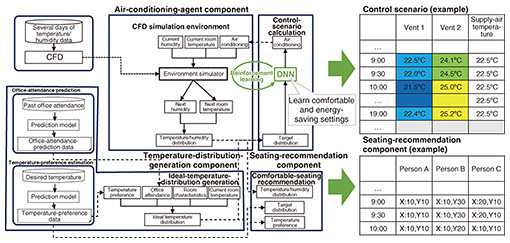 |
|||||||||||
|
|
|||||||||||
|
Feature Articles: Urban DTC for Creating Optimized Smart Cities Attentive to the Individual Vol. 22, No. 5, pp. 64–70, May 2024. https://doi.org/10.53829/ntr202405fa8 Personalized Air Conditioning Achieving Both Personal Comfort and Energy SavingsAbstractModern offices use uniform air-conditioning control, which means that office space cannot provide a comfortable environment for everyone since some people will feel cold and others will feel hot. Our aim is to achieve comfortable offices that make it easier for office users to do their work and improve their performance by providing air conditioning at temperatures tailored to personal preferences. In this article, we introduce our work in space control for achieving both energy saving and personal comfort. Keywords: air-conditioning control, AI, personalization 1. IntroductionAt NTT Smart Data Science Center (SDSC), we have developed an air-conditioning-control-scenario calculation technology, called predicted mean vote (PMV)*1 air-conditioning technology [1], for reducing energy consumption while maintaining a comfortable environment for visitors in the common sections of buildings by predicting an increase/decrease in the number of visitors and executing optimal control of air conditioning. We succeeded in reducing energy consumption by up to 50% in a building’s common sections in which people move about compared with exclusive sections by maintaining a temperature at which many people feel comfortable without taking personal preferences into account. This was accomplished by predicting an increase/decrease in the number of people so that air conditioning could be controlled efficiently. However, there can be considerable dissatisfaction in exclusive sections in which people tend to stay long if personal preferences are not met, so there is a need for air-conditioning control oriented to temperatures tailored to personal preferences. To improve energy efficiency throughout an entire building, therefore, we investigated personalized air-conditioning technology for reducing energy consumption while satisfying individual preferences. We describe our approach to developing our personalized air-conditioning technology that satisfies personal preferences in a single space, such as an office, in contrast to conventional air-conditioning control for an even and uniform environment.
2. Goal with personalized air-conditioning technologyThe usage format of office buildings can be broadly divided into common sections and exclusive sections. Corridors and lobbies, for example, are generally called common sections in which people rarely stay a long time and are usually moving about. In a common section, the time that one person stays is relatively short with many people come and go all the time. This makes it important to create an environment that feels comfortable to many people. However, in exclusive sections occupied by a variety of tenants in an office building, users stay for a relatively long time. Therefore, individual differences in what constitutes comfortable temperature and dissatisfaction with the temperature can significantly affect user comfort compared with common sections. Thinking about specific action, user behavior in an exclusive section can vary from individual work to meetings with several people, and places that are used by people within an office can likewise vary. Since there are individual differences in temperature and humidity preferences that are commonly expressed as sensitivity to heat or cold, and given that people tend to stay for a relatively long time in an exclusive section, we consider it necessary to provide comfortable air-conditioning control in a flexible manner and an environment that satisfies every individual. A comfortable environment is important in an exclusive section, but air conditioning consumes nearly half of a building’s energy consumption [2]. In seasons in which air conditioning is used more than usual (summers and winter), the pursuit of comfort generally requires much energy, and executing air-conditioning control simply for comfort’s sake can lead to an increase in energy consumption. At SDSC, we aim to achieve both personal comfort and energy saving for exclusive sections, the same as with our PMV air-conditioning technology for common sections described at the beginning of this article. With the spread of remote working, it can no longer be assumed that all seats in an office will be used, and seats and areas that are hardly used is increasing. It would therefore not be desirable to maintain a uniform temperature in all places within an exclusive section from the viewpoint of energy consumption. For this reason, our plan for personalized air conditioning is to create a variation in temperature not in the vertical direction but in the horizontal direction by creating locations with strong air conditioning and others with weak air conditioning by taking into account where individuals are located. We thus seek to achieve both personal comfort and energy saving, as mentioned above (Fig. 1).
3. Comparison with conventional building air-conditioning control3.1 Conventional air-conditioning controlIn office air conditioning, the typical approach is to set a temperature for an entire room or section and control air conditioning to achieve a uniform temperature. Thus, it would not seem possible to provide everyone with a comfortable environment since the type of work that people do and personal preferences with respect to temperature differ. If both hot and cold areas exist within an office, the blowout temperature of air-conditioning vents setting for either a hot or cold location may be changed on the basis of a request from a user. However, when changing temperature, the temperature in the vicinity of the requester will also change, affecting the comfort of surrounding users. The spread of remote working and the resulting phenomenon of sparsely occupied offices have made the energy consumed by applying uniform air-conditioning control at a fixed temperature an issue that needs to be addressed. 3.2 Air-conditioning-control-scenario calculation technology (PMV air-conditioning technology)Our PMV air-conditioning technology achieves both common comfort and energy saving in the common sections of a building. PMV is an index of personal comfort determined, for example, from temperature, humidity, heat radiation, air currents, amount of activity, and amount of clothing. For a common section, such as a corridor or lobby, in which many people are coming and going, our PMV air-conditioning technology has been successful in reducing energy consumption by up to 50% by predicting an increase or decrease in the number of people while keeping the PMV within a recommended comfort range [3]. This technology can be used to keep many people comfortable, but it cannot achieve a level of comfort supporting personal temperature preferences as required in an exclusive section of a building. We therefore investigated air-conditioning technology tailored to personal temperature preferences (personalized air-conditioning technology) based on air-conditioning control by using reinforcement learning we studied for our PMV air-conditioning technology. 3.3 Personalized air-conditioning technologyIn contrast to conventional air-conditioning control that operates air conditioning in a uniform manner at all locations whether or not users are present, the aim for exclusive sections of a building is air-conditioning control for efficiently achieving both personal comfort and energy saving by creating variation in temperature. This technology calculates temperature variation that should reflect the personal temperature preferences of everyone in an exclusive section as an ideal temperature distribution and determines an air-conditioning-control scenario by using artificial intelligence (AI) and setting this ideal temperature distribution as the objective. This air-conditioning-control scenario presents an operation plan that describes how the airflow and temperature of multiple air-conditioning vents should be set and how air-conditioning control is executed. Our aim is to achieve both personal comfort and energy saving by automatically controlling air conditioning in accordance with this scenario. We next describe the configuration of our personalized air-conditioning technology. 4. Configuration of personalized air-conditioning technologyTo reproduce an ideal temperature distribution with temperature variation in an actual office on the basis of the personal preference of each user, our personalized air-conditioning technology consists of three major components: temperature-distribution generation, air-conditioning agent, and seating recommendation (Fig. 2).
The temperature-distribution-generation component calculates an ideal temperature distribution that should be achieved within an office according to each user’s temperature preference and office-attendance conditions. To determine beforehand whether a user plans to be at the office, this component makes a prediction using the office-attendance-prediction function. By taking into account each user’s temperature preference may change in accordance with outside temperature and other factors, it estimates the temperature then calculates an ideal temperature distribution that should be achieved within that office by calculating the ideal temperature distribution on the basis of the temperature-preference and office-attendance information determined beforehand. Targeting the ideal temperature distribution calculated described above, the air-conditioning-agent component sets up an air-conditioning-control policy in a simulation environment, calculates an optimal air-conditioning-operation scenario, and reproduces a temperature distribution with temperature variation. Finally, the seating-recommendation component recommends work locations corresponding to user comfort from a future temperature distribution on the basis of air-conditioning-control prediction. The following sections describe these components in more detail. 4.1 Temperature-distribution generationThe temperature-distribution-generation component generates the target temperature distribution (ideal temperature distribution) required by the air-conditioning agent to control air conditioning. It first estimates user-temperature preferences using a history of user orders for desired temperature to create locations reflecting those user-temperature preferences. It then predicts office attendance for each user to control air conditioning in accordance with user presence in the office. Finally, it calculates an ideal temperature distribution from the above information and air-conditioning-load characteristics within the office (room characteristics) for use by the air-conditioning agent as its target distribution. (1) Temperature-preference estimation Although it is possible to use temperature preferences based on self-reports from users to generate an ideal temperature distribution and achieve temperature variation by controlling air conditioning accordingly, it is thought that accurately understanding one’s own temperature preference would likely be difficult for a user. To understand users’ preferred temperatures, we obtain orders from users for desired locations or temperatures within an office via an integrated app, for example. In short, this function estimates the temperature preference of each user from historical information on temperatures at locations where users have been present within the office and on desired temperatures such as higher temperatures (when it is cold) or lower temperatures (when it is warm). (2) Office-attendance prediction It is necessary to determine whether a particular user will be coming to the office to generate a temperature distribution that reflects the user’s preferred temperature after arriving at the office. This function accumulates a history of attendance for each user as training data via an integrated app or other means and predicts whether the user will be at the office so that an ideal temperature distribution can be generated. (3) Ideal-temperature-distribution generation This function generates an ideal temperature distribution using temperature preferences and attendance prediction described above, information on room characteristics obtained by analyzing the trend of warming and cooling at each office location, and the temperature distribution at that time. Even within an office, there are locations where temperature can easily rise or fall due to factors such as outside air temperature, sunlight, and placement of air-conditioning vents, which can affect air-conditioning load. To achieve air-conditioning control with good energy efficiency, room characteristics need to be determined by analyzing temperature distributions within the office during times of air-conditioning control over several days. These room characteristics, information on user temperature preferences, and information on office attendance can be used to generate an ideal temperature distribution that can save energy while satisfying user comfort. 4.2 Air-conditioning agentThe air-conditioning-agent component uses an environment simulator that reproduces an office environment to output an air-conditioning-control scenario for reproducing an ideal temperature distribution on the basis of reinforcement learning. An air conditioner that automatically executes air-conditioning control according to this air-conditioning-control scenario changes the settings of vents, supply-air temperature, etc. at different points in time and performs energy-saving air-conditioning control that also satisfies personal comfort. Our PMV air-conditioning technology also calculates and controls an air-conditioning-control scenario using an environment simulator and reinforcement learning. Our personalized air-conditioning technology achieves energy-saving air-conditioning control that satisfies personal comfort by constructing a detailed simulation environment with finely arranged temperature sensors, preparing a target temperature distribution that sets a temperature for each user seat as a control target, and applying reinforcement learning in combination with multiple control targets such as supply-air temperature, blowout temperature (air volume) of vents, and airflow devices. Both our PMV air-conditioning and personalized air-conditioning technologies calculate a control scenario through reinforcement learning of air-conditioning control. In evaluating rewards such as energy efficiency through air-conditioning control, the air-conditioning load may drop at a certain instant but may also increase later resulting in an increase in energy consumption, so such an evaluation cannot be conducted only at that instant. It is therefore necessary to evaluate whether energy consumption can be minimized while achieving target temperatures by air-conditioning control over the course of a day. To execute complicated control of control points such as air-volume output from multiple vents and temperature of air supplied to each vent and to conduct long-term evaluations, we have been calculating air-conditioning-control scenarios using reinforcement learning. (1) Computational-fluid-dynamics simulation environment Executing air-conditioning control by reinforcement learning requires searching for optimal air-conditioning control by changing and controlling a variety of settings such as supply-air temperature and blowout temperature in accordance with temperature conditions within the environment and acquiring an optimal control method toward the target temperature distribution. This requires tens of thousands of trials using many conditions and control settings, so conducting actual trials in an actual space is difficult. For this reason, we reproduce environments using computational fluid dynamics (CFD)*2 that can simulate temperature and airflow. Applying ordinary CDF requires the setting of complex parameters using specialized knowledge in relation to fluid dynamics, but we estimate CFD parameters by placing multiple temperature sensors within an exclusive section. We simulate air-conditioning control using this environment. (2) Control-scenario calculation by reinforcement learning We use reinforcement learning in a simulation environment to calculate an air-conditioning-control scenario. Using this simulation environment, we learn how air-conditioning supply-air temperature and air volume at a certain temperature distribution can be set to achieve the target temperature distribution while minimizing energy consumption. Using such a simulation environment enables a trial-and-error process with many variations, but searching for optimal air-conditioning control for a variety of target temperature distributions results in high computational complexity. To solve this problem, we efficiently search for optimal air-conditioning control by sampling locations such as seats where users are assumed to be present from the temperature distribution reproduced in the simulation environment and the target temperature distribution and by using the difference between the reproduced temperature and target temperature at each sampling point as training input (Fig. 3).
4.3 Seating recommendationThe seating-recommendation component recommends a location within a room where time can be passed in a comfortable manner to each user on the basis of the user’s temperature preference, orders placed by the user requesting office temperature to be changed, and the current-temperature distribution and future-temperature distribution to be reproduced in the room. (1) Current-temperature distribution Proposing an optimal seat or location within an office when the user wishes to move requires the temperature distribution at that time. However, installing temperature sensors at all seats or locations within an exclusive section to measure the temperature at each location is difficult in terms of cost and securing those installation locations. Therefore, we use temperature information obtained from a number of discretely placed temperature sensors to predict the temperature distribution throughout the office and calculate the current-temperature distribution. We construct a prediction model for office temperature from the history of temperature-sensor information at each point to predict temperature even at locations where no temperature sensor is installed. (2) Future-temperature distribution When a user comes to work or decides to move seats, the temperature distribution to be reproduced in the future is needed. The temperature distribution at different time points in the future is determined on the basis of the operation scenario computed by the air-conditioning agent and of air-conditioning control in the simulation environment. (3) Comfortable-seating recommendation When a user arrives at the office or places an order requesting a change in temperature, this function recommends a location that satisfies user comfort or a location that will satisfy it in the future. When the comfort of other users would be affected or the energy efficiency of air conditioning would be degraded, there are times when it would be more appropriate to suggest people to change seats rather than make major changes to air conditioning to satisfy the comfort of many users and reduce energy consumption. This function calculates the location that would satisfy the user’s temperature preference over the long term from the temperature distribution in the office at that time and temperature distribution planned for the future and recommends a location that matches the user’s temperature preference.
5. Issues and future outlookThe following issues must be addressed in implementing our personalized air-conditioning technology. (1) Prediction of user movement within a room We can predict whether a user will be coming to work, but to control air conditioning tailored to user movement, it will be necessary to predict where users will be located within the room and reflect that in the ideal temperature distribution. (2) Improving the resolution of reproduced temperature distributions To control the desired temperatures of many users with pinpoint accuracy, it will be necessary to achieve high resolution in both the spatial and temporal directions such as by increasing the control targets that act on air conditioning. Going forward, we plan to verify the effectiveness of seating recommendations in an office tailored to users’ preferred temperatures and air-conditioning control tailored to actual user behavior. References
|
|||||||||||














